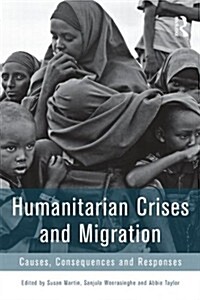
Humanitarian crises and migration: causes, consequences and responses
- 발행사항
- New York, NY : Abingdon, Oxon ; Routledge, 2014
- 형태사항
- 375p. ; 24cm
- ISBN
- 9780415857321
- 청구기호
- 331.54 M383h
- 서지주기
- Includes bibliographical references and index
소장정보
| 위치 | 등록번호 | 청구기호 / 출력 | 상태 | 반납예정일 |
|---|---|---|---|---|
이용 가능 (1) | ||||
| 1자료실 | 00015098 | 대출가능 | - | |
- 등록번호
- 00015098
- 상태/반납예정일
- 대출가능
- -
- 위치/청구기호(출력)
- 1자료실
책 소개
Whether it is the stranding of tens of thousands of migrant workers at the Libyan?Tunisian border, or the large-scale displacement triggered by floods in Pakistan and Colombia, hardly a week goes by in which humanitarian crises have not precipitated human movement. While some people move internally, others internationally, some temporarily and others permanently, there are also those who become "trapped" in place, unable to move to greater safety. Responses to these "crisis migrations" are varied and inadequate. Only a fraction of "crisis migrants" are protected by existing international, regional or national law. Even where law exists, practice does not necessarily guarantee safety and security for those who are forced to move or remain trapped. Improvements are desperately needed to ensure more consistent and effective responses.
This timely book brings together leading experts from multi-disciplinary backgrounds to reflect on diverse humanitarian crises and to shed light on a series of exploratory questions: In what ways do people move in the face of crisis situations? Why do some people move, while others do not? Where do people move? When do people move, and for how long? What are the challenges and opportunities in providing protection to crisis migrants? How might we formulate appropriate responses and sustainable solutions, and upon what factors should these depend? This volume is divided into four parts, with an introductory section outlining the parameters of "crisis migration," conceptualizing the term and evaluating its utility. This section also explores the legal, policy and institutional architecture upon which current responses are based. Part II presents a diverse set of case studies, from the earthquake in Haiti and the widespread violence in Mexico, to the ongoing exodus from Somalia, and environmental degradation in Alaska and the Carteret Islands, among others. Part III focuses on populations that may be at particular risk, including non-citizens, migrants at sea, those displaced to urban areas, and trapped populations. The concluding section maps the global governance of crisis migration and highlights gaps in current provisions for crisis-related movement across multiple levels.
This valuable book brings together previously diffuse research and policy issues under the analytical umbrella of "crisis migration." It lays the foundations for assessing and addressing real challenges to the status quo, and will be of interest to scholars, policy makers, and practitioners committed to seeking out improved responses and ensuring the dignity and safety of millions who move in the context of humanitarian crises.
This edited volume brings together leading experts from multi-disciplinary backgrounds to address the broad range of movements caused or occurring in the context of acute and slow-onset humanitarian crises.
목차
Part One: Introduction and a Theoretical Perspective Chapter 1: Setting the SceneSusan F. Martin, Sanjula Weerasinghe And Abbie Taylor Chapter 2: Conceptualizing "Crisis Migration": A Theoretical Perspective Jane McAdam Part Two: Case Studies of Humanitarian Crises: Movements, Protection Implications and Responses Chapter 3: Rising Waters, Broken Lives: Experience from Pakistan and Colombia Floods Suggests New Approaches are Needed Alice Thomas Chapter 4: Recurrent Acute Disasters, Crisis Migration: Haiti Has Had It All Elizabeth Ferris Chapter 5: Health Crises and Migration Michael Edelstein, Khalid Koser and David L. Heymann Chapter 6: Criminal Violence, Displacement, and Migration in Mexico and Central America Sebastian Albuja Chapter 7: Intractability and Change in Crisis Migration: North Koreans in China and Burmese in Thailand W. Courtland Robinson Chapter 8: Environmental Processes, Political Conflict and Migration: A Somali Case Study Anna Lindley Chapter 9: Environmental Stress, Displacement and the Challenge of Rights Protection Roger Zetter and James Morrisey Chapter 10: Enhancing Adaptation Options and Managing Human Mobility in the Context of Climate Change Koko Warner and Tamer Afifi Chapter 11: Community Relocations: The Arctic and South Pacific Robin Bronen Chapter 12: Something Old and Something New: Resettlement in the Twenty First CenturyAnthony Oliver-Smith and Alex De Sherbinin Part Three: At Risk PopulationsChapter 13: Protecting Non-Citizens in Situations of Conflict, Violence, and Disaster Khalid Koser Chapter 14: ‘Trapped’ Populations: Controls on Mobility at Times of Crises Michael Collyer and Richard Black Chapter 15: Policy Adrift: The Challenge of Mixed Migration By Sea Judith Kumin Chapter 16: Flight to the Cities: Urban Options and Adaptations Patricia Weiss Fagen Part Four: Governance Chapter 17: The Global Governance of Crisis Migration Alexander Betts
